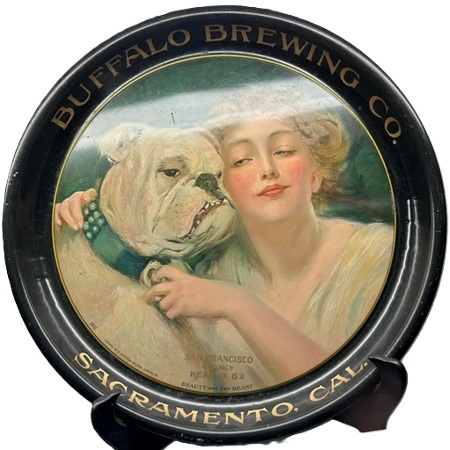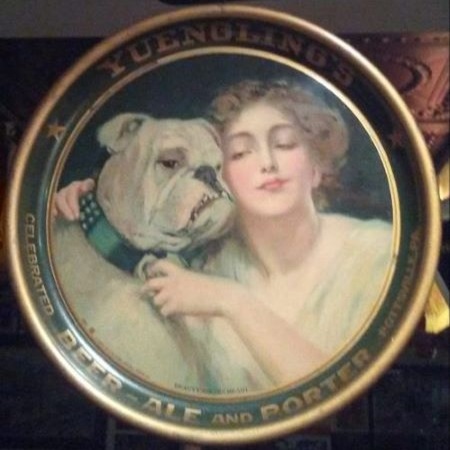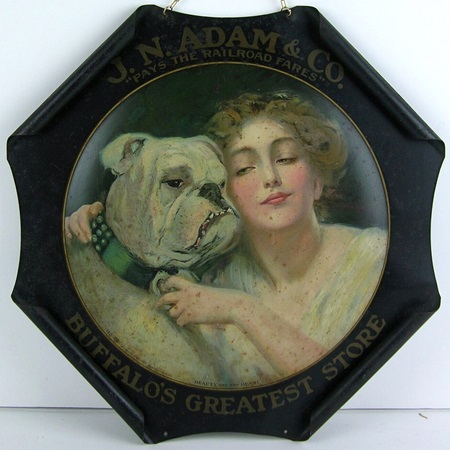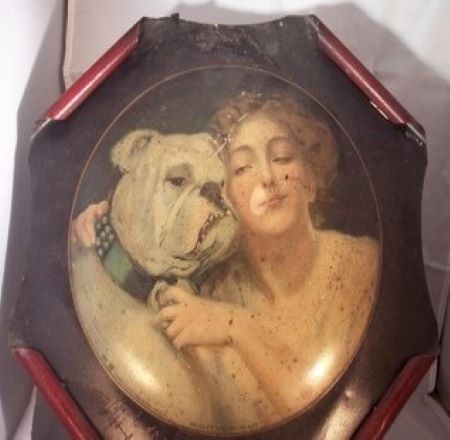The 'Stock' Exchange
American Art Works No. 120 "Beauty & the Beast"
American Art Works No. 120 "Beauty & the Beast"
Date: 1910 - 1911
Size: 13"
Type: Pie
Scarcity: Hard to Find
Value: $$$$
Condition & Brewer Dependent
Size: 13"
Type: Pie
Scarcity: Hard to Find
Value: $$$$
Condition & Brewer Dependent
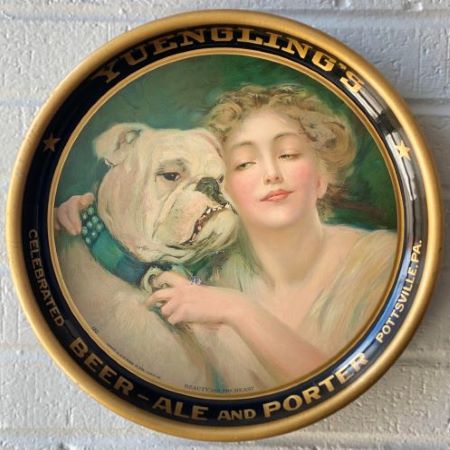
General
It is somewhat puzzling why No. 120 is such a scarce design with only three known issuers. In fact, several of the trays from this timeframe are somewhat scarce or less common. At the time of his NABA article Hager had not yet identified No. s 122-125 (Right to the Point dogs, At Peace with Nature, Evangeline and The Fish Story). It’s possible there was some disruption in design and production following the 1910 name change to American Art Works.
It is somewhat puzzling why No. 120 is such a scarce design with only three known issuers. In fact, several of the trays from this timeframe are somewhat scarce or less common. At the time of his NABA article Hager had not yet identified No. s 122-125 (Right to the Point dogs, At Peace with Nature, Evangeline and The Fish Story). It’s possible there was some disruption in design and production following the 1910 name change to American Art Works.
Sources indicate that ownership was actively searching for a permanent replacement to the active and involved Jasper meek. In fact, Adolph Sahling’s workbook indicates that for unknown reasons he left AAW to work for H D Beach from August until November 1911. The last stock design in his workbook is “The Invitation, No. 116” and does not resume until No. 121 (Jeanette) following his return to AAW. Prior to his departure Sahling had been involved in the production of most of the stock designs, so No. 120 was clearly designed by another artist and careful examination reveals a less precise artistic style than had been produced up to that time. Perhaps potential advertisers were not comfortable with this change.
Another theory we had heard that may explain this lack of popularity is that certain advertisers ended up buying the exclusive rights to what had meant to be a stock design. For example, “Jan” and “Greit” which have clear stock design elements, but for whom the only examples appear to be from the Los Angeles Brewing Co and the Humboldt Brewing Co (an affiliate of Los Angeles Brewing).
Looking for a literary or artistic source/inspiration for this image is a challenge given the ubiquitous Disney story and associated movies, which was based on well known fairy tales from Europe (seemingly each company had its own version). These fairy tales were based on Jeanne-Marie Leprince de Beaumont's 1740 French fairy tale 'Beauty and the Beast. In turn, Leprince’s story is supposedly based on the real 16th century case of Petrus Gonsalvus who suffered from a genetic condition known as hypertrichosis (also known as Ambras syndrome), which is defined by an abnormal amount of hair growth on any part of the body in excess of the regular amount present in people of the same race, age and gender. In Gonsalvus' case, it affected his entire body. It has also been referred to informally as werewolf syndrome because the appearance is akin to the mythical werewolf—truly a beast.
At a young age, Gonsalvus was treated as an uncivilized curiosity. The hairy "wild man" was captured and put into an iron cage. For food, he was given raw meat and animal feed. He was shipped to King Henry II of France as a gift for the king's coronation in 1547.
Fortunately, King Henry II did not see Gonsalvus as a freak that should be kept in a cage. The king recognized Gonsalvus' calm demeanor and decided to try an experiment. He would attempt to educate and transform him into a gentleman. The king allowed him to keep his birth name, Pedro González, but only if he used its Latin form, Petrus Gonsalvus. The boy was given clothes and cooked meals. He was taught to speak, read, and write in not just one, but three languages, receiving the education of a nobleman.
The real Beauty and the Beast met after Gonsalvus' mentor and protector, King Henry II, was killed in a jousting match on July 10, 1559. Gonsalvus became the property of the king's widow, Catherine de Medici, who became ruler and decided to conduct her own experiment with Gonsalvus. She wondered what would happen if her "beast" married a beautiful woman. Would they conceive little beasts? She found a wife for Gonsalvus, a young maiden also named Catherine, who was the daughter of a royal court servant.
Petrus Gonsalvus met his wife Catherine for the first time on their wedding day. The pair had seven children, with four of the seven suffering from their father's condition, hypertrichosis. Petrus and Catherine were married for more than 40 years, with Catherine passing in 1623 and Petrus several years prior. There is no record of his death, possibly because he was not considered a human being worthy of a Christian burial, and therefore his death was not recorded. Petrus was last mentioned in the year 1617 at the christening of his grandson, and he is believed to have passed away sometime around 1618. The family's story spread throughout the region, eventually becoming the inspiration for one of the most popular love stories in literature, and subsequently, modern cinema.
Shape & Rim and Advertising Placement
Known tray examples are all concave 13” rounds with the low pie shaped rim and rolled edge. Rims were a solid color (black or green) with advertising text on the rim. They were also produced as a curled corner sign, a later sign form that one imagines was less expensive to produce that a TOC version.
Variations of the tray exist with both black and dark green rims for Yuengling. It is not clear why it exists in two different colors; it may indicate that two runs were ordered at different times and for some unknown reason a different rim color was chosen.
Hager & Price
Hager has this design in his catalog but does not discuss it in his article, other than to place its release in 1911. The only brewery examples we’ve seen have come from Yuengling and a single example from Buffalo Brewing. Prices are very often in the four figures (depending on condition). We’ve only seen a single unmarked stock sample, which was significantly lower and a few curled corner sign examples from a single issuer (J N Adams & Co which was a retail store in Buffalo, NY) for whom prices are surprisingly strong for a non-brewery.
Another theory we had heard that may explain this lack of popularity is that certain advertisers ended up buying the exclusive rights to what had meant to be a stock design. For example, “Jan” and “Greit” which have clear stock design elements, but for whom the only examples appear to be from the Los Angeles Brewing Co and the Humboldt Brewing Co (an affiliate of Los Angeles Brewing).
Looking for a literary or artistic source/inspiration for this image is a challenge given the ubiquitous Disney story and associated movies, which was based on well known fairy tales from Europe (seemingly each company had its own version). These fairy tales were based on Jeanne-Marie Leprince de Beaumont's 1740 French fairy tale 'Beauty and the Beast. In turn, Leprince’s story is supposedly based on the real 16th century case of Petrus Gonsalvus who suffered from a genetic condition known as hypertrichosis (also known as Ambras syndrome), which is defined by an abnormal amount of hair growth on any part of the body in excess of the regular amount present in people of the same race, age and gender. In Gonsalvus' case, it affected his entire body. It has also been referred to informally as werewolf syndrome because the appearance is akin to the mythical werewolf—truly a beast.
At a young age, Gonsalvus was treated as an uncivilized curiosity. The hairy "wild man" was captured and put into an iron cage. For food, he was given raw meat and animal feed. He was shipped to King Henry II of France as a gift for the king's coronation in 1547.
Fortunately, King Henry II did not see Gonsalvus as a freak that should be kept in a cage. The king recognized Gonsalvus' calm demeanor and decided to try an experiment. He would attempt to educate and transform him into a gentleman. The king allowed him to keep his birth name, Pedro González, but only if he used its Latin form, Petrus Gonsalvus. The boy was given clothes and cooked meals. He was taught to speak, read, and write in not just one, but three languages, receiving the education of a nobleman.
The real Beauty and the Beast met after Gonsalvus' mentor and protector, King Henry II, was killed in a jousting match on July 10, 1559. Gonsalvus became the property of the king's widow, Catherine de Medici, who became ruler and decided to conduct her own experiment with Gonsalvus. She wondered what would happen if her "beast" married a beautiful woman. Would they conceive little beasts? She found a wife for Gonsalvus, a young maiden also named Catherine, who was the daughter of a royal court servant.
Petrus Gonsalvus met his wife Catherine for the first time on their wedding day. The pair had seven children, with four of the seven suffering from their father's condition, hypertrichosis. Petrus and Catherine were married for more than 40 years, with Catherine passing in 1623 and Petrus several years prior. There is no record of his death, possibly because he was not considered a human being worthy of a Christian burial, and therefore his death was not recorded. Petrus was last mentioned in the year 1617 at the christening of his grandson, and he is believed to have passed away sometime around 1618. The family's story spread throughout the region, eventually becoming the inspiration for one of the most popular love stories in literature, and subsequently, modern cinema.
Shape & Rim and Advertising Placement
Known tray examples are all concave 13” rounds with the low pie shaped rim and rolled edge. Rims were a solid color (black or green) with advertising text on the rim. They were also produced as a curled corner sign, a later sign form that one imagines was less expensive to produce that a TOC version.
Variations of the tray exist with both black and dark green rims for Yuengling. It is not clear why it exists in two different colors; it may indicate that two runs were ordered at different times and for some unknown reason a different rim color was chosen.
Hager & Price
Hager has this design in his catalog but does not discuss it in his article, other than to place its release in 1911. The only brewery examples we’ve seen have come from Yuengling and a single example from Buffalo Brewing. Prices are very often in the four figures (depending on condition). We’ve only seen a single unmarked stock sample, which was significantly lower and a few curled corner sign examples from a single issuer (J N Adams & Co which was a retail store in Buffalo, NY) for whom prices are surprisingly strong for a non-brewery.


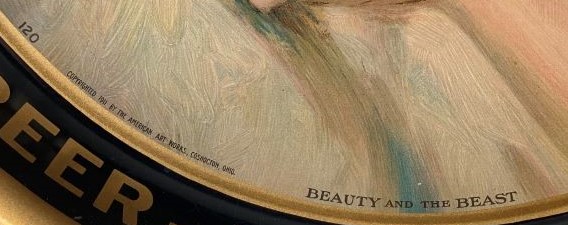
Confirmed Brewer used Stock Trays
Non-Beer Related & Non-Tray Uses
Click the Picture to Return to Meek & Beach Stock Catalog Page
